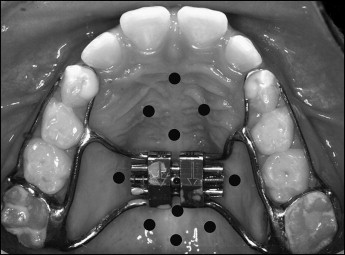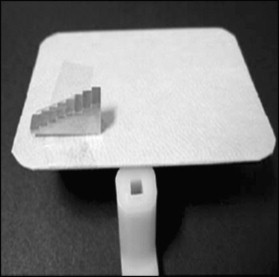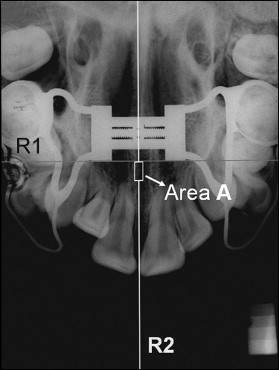Introduction
In this study, we evaluated the effects of a low-level laser on bone regeneration in rapid maxillary expansion procedures.
Methods
Twenty-seven children, aged 8 to 12 years, took part in the experiment, with a mean age of 10.2 years, divided into 2 groups: the laser group (n = 14), in which rapid maxillary expansion was performed in conjunction with laser use, and the no-laser group (n = 13), with rapid maxillary expansion only. The activation protocol of the expansion screw was 1 full turn on the first day and a half turn daily until achieving overcorrection. The laser type used was a laser diode (TWIN Laser; MMOptics, São Carlos, Brazil), according to the following protocol: 780 nm wavelength, 40 mW power, and 10 J/cm 2 density at 10 points located around the midpalatal suture. The application stages were 1 (days 1-5 of activation), 2 (at screw locking, on 3 consecutive days), 3, 4, and 5 (7, 14, and 21 days after stage 2). Occlusal radiographs of the maxilla were taken with the aid of an aluminum scale ruler as a densitometry reference at different times: T1 (initial), T2 (day of locking), T3 (3-5 days after T2), T4 (30 days after T3), and T5 (60 days after T4). The radiographs were digitized and submitted to imaging software (Image Tool; UTHSCSA, San Antonio, Tex) to measure the optic density of the previously selected areas. To perform the statistical test, analysis of covariance was used, with the time for the evaluated stage as the covariable. In all tests, a significance level of 5% ( P <0.05) was adopted.
Results
From the evaluation of bone density, the results showed that the laser improved the opening of the midpalatal suture and accelerated the bone regeneration process.
Conclusions
The low-level laser, associated with rapid maxillary expansion, provided efficient opening of the midpalatal suture and influenced the bone regeneration process of the suture, accelerating healing.
Rapid maxillary expansion is a commonplace therapeutic practice in orthodontics. The lateral repositioning of the maxilla, with an increase in bone mass in the center, promotes marked changes in the morphology of the maxillary arch, leading to irrefutable advantages in the mechanotherapy of transverse maxillary deficiencies. Evidence of this movement can easily be observed in occlusal radiographs of the maxilla.
Several studies have confirmed that low-level lasers can speed bone regeneration of the midpalatal suture in rapid maxillary expansion procedures, in addition to stimulating the synthesis of collagen, which is mainly responsible for the osteoid matrix. However, some authors have commented on the need for further studies to elucidate the action mechanism of infrared rays and their conditions of use in patients, since the protocols of laser use are contradictory in the literature.
Several authors studied the effect of low-level laser irradiation on bone regeneration during expansion of the midpalatal suture. They concluded that the low-level laser significantly stimulated bone regeneration of the midpalatal suture during expansion, in addition to accelerating its opening.
Cobo et al and Sannomiya et al, among other authors, carried out studies using specific programs to evaluate optical density in the tracking of bone regeneration processes, based on sequential digitized radiographs, in which subtle differences in density can be determined, given by a histogram, representing differences in bone regeneration by comparing differences in density. Optical density is a gray scale, which varies from 0, representing absolute black, up to 255, which represents absolute white. For a more reliable evaluation of optical density, the use of an aluminum scale (step wedge) is recommended to calibrate the radiopacity of the radiograph.
Thus, the objective of this study was to evaluate the effects of a low-level laser on the midpalatal suture in rapid maxillary expansion procedures, by analyzing optical density and comparing a group of patients who underwent laser therapy with a control group who had rapid maxillary expansion without laser use.
Material and methods
This project was submitted to the committee of ethics of the Methodist University of São Paulo, Brazil, and approved with protocol number 142.170/07.
We used 128 occlusal radiographs obtained from 27 patients who underwent rapid maxillary expansion, with a mean initial age of 10.2 years (range, 8.2-12.1 years). The subjects were selected randomly before the start of treatment and divided into 2 groups. The laser group (experimental) received rapid maxillary expansion with laser application; it included 14 patients (7 girls, 7 boys) with a mean age of 10.29 years. The no-laser group (control) had rapid maxillary expansion without laser application; it included 13 patients (6 girls, 7 boys) with a mean age of 10.22 years.
The radiographs were obtained at different times: T1, start (25 radiographs); T2, immediately after the expander appliance activations (25 radiographs); T3, 3 to 5 days after T2 (25 radiographs); T4, 30 days after T3 (26 radiographs); and T5, 60 days after T4 (27 radiographs). The number of radiographs varied because some patients were absent for taking the x-rays, but they did not have to be excluded from the sample.
The device chosen for expansion was a hyrax expander (DENTSPLY GAC International, Bohemia, NY), modified for the mixed dentition. This appliance consisted of a screw with a 13-mm opening capacity, loops on the permanent first molars, and contour on the deciduous molars and canines by means of a nickel-chromium wire soldered onto the loops on the lingual and buccal surfaces of the teeth, fixed by using light-cured resins and glass ionomer cement on the loops.
The activation procedure for the expansion screw was done according to the following protocol: 4 activations on the first day (1 full turn) and 2 daily activations on the following days (half turn). Expansion was performed until the desired overcorrection was achieved, visualized clinically by the lingual cusp of the maxillary molars, in the direction of the buccal cusps of the mandibular molars. After the end of activation, which lasted approximately 8 days, the appliance was left on for another 90 days in the same position with a retaining function and was then removed to be replaced by an acrylic retainer plate.
The level of opening of the screws in both groups was evaluated by measuring 2 points located on each half of the screw on the central part. Measurements were taken before and after the activations by using a digital paquimeter (Mitutoyo, São Paulo, Brazil). To determine precisely the final opening of the expansion screw, these measurements were subtracted, based on the methodology already described by Hino et al.
The laser used was a diode (TWIN Laser; MMOptics, São Carlos, Brazil) with the following irradiation protocol: wavelength, 780 nm; spot area, 0.04 cm 2 ; energy per point, 0.4 J; number of points, 10; total energy, 4 J; time per point, 10 seconds; power, 40 mW; and density, 10 J/cm 2 , according to the security criteria for the use of the laser.
Application was done in points, distributed in 4 points anterior to the screw, 2 lateral points, the point closest to the midpalatal suture, and 4 points posterior to the screw, totaling 10 points around the midpalatal suture, as shown in Figure 1 .

Applications were made in the following stages: 1, from the start of expansion screw activation until 5 days later; 2, immediately after the end of expansion for 3 consecutive days; 3, 7 days after stage 2; 4, 7 days after stage 3; and 5, 7 days after stage 4.
All radiographs were taken according to the same standardization described by Sannomiya et al and Hino et al, with a step wedge, a scale made of pure aluminum, distributed homogenously along its entire structure, with 8 steps varying in thickness from 1 to 8 mm and fixed on the anterior border of the film, which served as a comparative densitometric reference ( Fig 2 ).

The occlusal radiographs were digitized by using a scanner (PowerLook 1000; Umax, Taipei, Taiwan) with 300 dpi resolution. With the aid of an imaging software program (version 5.5; Adobe Photoshop, San Jose, Calif), 2 straight lines were drawn. The first (R1) was a straight line horizontal to the border of the film, touching and uniting the 2 halves of the expansion screw. The second (R2), drawn perpendicular to R1, was located at the center of the expansion screw, following the path of the midpalatal suture. After drawing the reference lines, the area of interest to be analyzed was delimited, named area A, and centered with R2 in the same slope as R1, measuring 21.3 × 46.1 pixels, or 1.8 × 3.9 mm, as shown in Figure 3 .

The images were transferred to a computer and saved in JPEG format (300 dpi). The optical density software program (Image Tool; UTHSCSA, San Antonio, Tex) was used; it has been widely mentioned in the literature to aid in measuring the optical density of the area of interest through a histogram equivalent to the gray scale of the analyzed area.
After we defined the step to be measured from the area of the step wedge (SW), the values relative to the shades of gray of areas A and SW were submitted to a mathematical calculation to transform the units of measurement of shades of gray into millimeters and then obtain the optical density of the area of interest analyzed. This procedure was performed in all radiographs of both groups, so that the comparison could be made of bone regeneration in the midpalatal suture, regardless of the density of each radiograph. This was always done with the aluminum equivalent millimeters unit: the higher the value, the more bone is present in the area, characterized by a more radiopaque area in the radiograph.
Statistical analysis
Method error evaluation was carried out 30 days after the first measurement with 30% of the sample. To verify intraexaminer system error, the paired t test was used. To determine casual error, Dahlberg’s error calculation was used.
The Student t test was used for comparing the laser and no-laser groups for the following characteristics: initial age, time between phases, and distances of the expansion screw.
Results
The comparisons between the 2 groups showed statistically significant differences for times T3 to T2, T4 to T2, and T5 to T4. Analysis of covariance (ANCOVA) was used for this factor to be considered when the densities of the groups were compared. The covariable was the time for the evaluated phase. In all tests, a significance level of 5% ( P <0.05) was adopted. All statistical procedures were executed by using Statistica for Windows (version 5.1; StatSoft, Tulsa, Okla).
The results of the evaluations of systematic error by paired t test and casual error measured by Dahlberg’s formula are shown in Table I ; there were minimal differences, not statistically significant, indicating the reliability of our methodology.
| Measurement 1 | Measurement 2 | t | P | Error | ||
|---|---|---|---|---|---|---|
| Mean | SD | Mean | SD | |||
| 5.94 | 1.19 | 5.94 | 1.20 | 0.309 | 0.759 NS | 0.10 |
To compare the 2 sample groups, the means, standard deviations, and Student t test results were taken of the characteristics shown in Table II , which shows that the initial ages of the patients in both groups were similar, as were the amounts of screw opening, both of which allowed us to make reliable comparisons of the groups.
| Characteristic | Laser | No laser | P | ||||
|---|---|---|---|---|---|---|---|
| n | Mean | SD | n | Mean | SD | ||
| Initial age (mo) | 14 | 123.50 | 13.01 | 13 | 122.69 | 17.20 | 0.891 NS |
| Screw, start (mm) | 14 | 1.82 | 0.19 | 13 | 1.83 | 0.16 | 0.902 NS |
| Screw, final (mm) | 14 | 7.33 | 1.36 | 13 | 8.34 | 1.25 | 0.056 NS |
| Screw, difference (mm) | 14 | 5.51 | 1.35 | 13 | 6.51 | 1.20 | 0.053 NS |
Table III shows the means, standard deviations, and ANCOVA results of the optical density comparisons in all 5 radiograph times for both groups, demonstrating that at T1 the 2 groups were comparable, proving that the sample started with similar initial densities. At T2, T3, and T4, the densities between the groups were different. This indicated that bone regeneration took place differently, and then density became similar again at T5, even though the laser group had a higher mean density than the no-laser group (not statistically significant). The unit of measurement utilized was mm Eq/Al (equivalent milimeters of aluminum), which indicates bone density. The higher the score, the more radiopacity is present and therefore the bone more dense.
| Time | Laser | No laser | P | ||||
|---|---|---|---|---|---|---|---|
| n | Mean | SD | n | Mean | SD | ||
| T1 | 14 | 6.65 | 0.79 | 11 | 6.75 | 0.87 | 0.757 NS |
| T2 | 14 | 5.04 | 0.54 | 11 | 6.01 | 1.25 | 0.016 ∗ |
| T3 | 13 | 5.16 | 0.88 | 12 | 6.05 | 0.77 | 0.008 ∗ |
| T4 | 14 | 5.35 | 0.55 | 12 | 6.48 | 1.01 | 0.006 ∗ |
| T5 | 14 | 7.11 | 0.96 | 13 | 6.58 | 1.15 | 0.184 NS |
Figure 4 illustrates the behavior of the midpalatal suture when the 2 groups were compared during the different evaluation stages.




